
If your tiled floors look outdated or worn, you might be wondering whether painting them could be a quick, budget-friendly alternative to a full renovation. The short answer is yes – you can paint floor tiles, and with the right preparation, the results can be surprisingly effective.
Painted floor surfaces can give your home a completely fresh look without the mess and cost of ripping everything out. That said, it’s important to know what you’re getting into before you open a can of tile paint.
Luckily, we have prepared a comprehensive blog post on how to paint tile floors.
Painting Floor Tiles: Pros and Cons
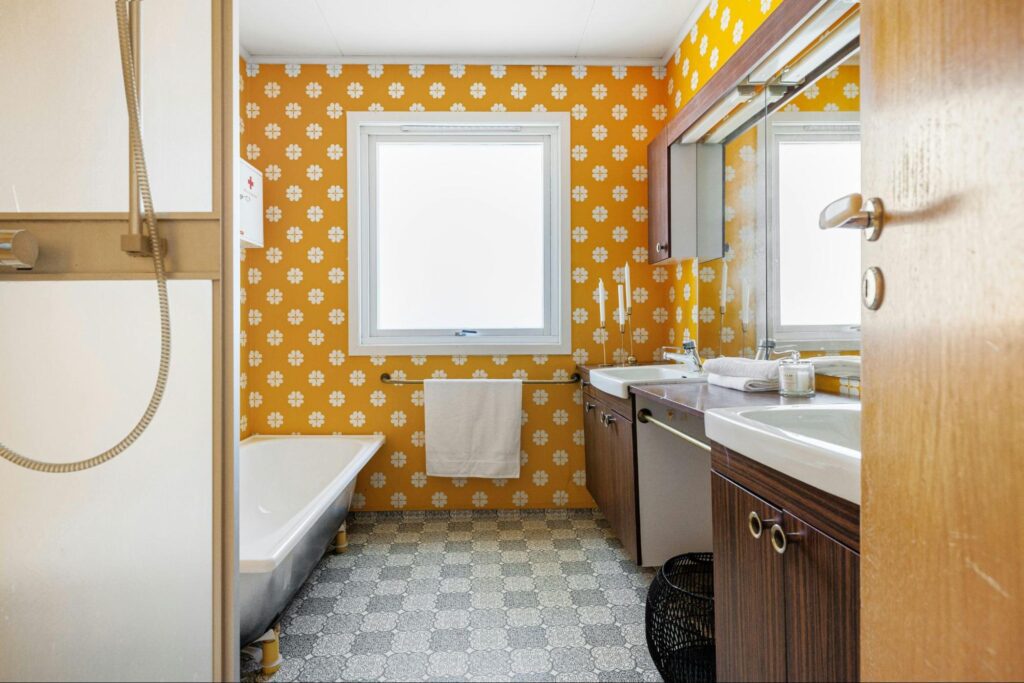
Like any home improvement project, painting floor tiles comes with its benefits and drawbacks. Knowing these upfront will help you decide whether this option is right for your space.
The pros of painting the floors are:
- Cost-effective – painting ceramic floor tiles is far cheaper than replacing them, especially if you’re working on a large room or small space.
- Quick refresh – just one coat of floor paint can make a huge difference and completely transform an outdated floor in a weekend.
- Customisation – from solid colours to bold stencils or patterns, you can get creative and personalise your tile floor.
- DIY-friendly – with some preparation and patience, most homeowners can tackle this project themselves using a paint brush, small roller, and some masking tape for the edges.
As you can see, painting the existing tiles is a budget-friendly option for lovers of DIY projects. Having said that, you also have to know the cons of the project.
The cons of painting the floor tiles are:
- Durability – even with a top coat, a painted floor can chip or scratch in high-traffic areas, especially with wet shoes. Placing rugs or mats in busy spots can help extend their life.
- Moisture sensitivity – bathrooms and kitchens require extra care, as water and humidity can cause the paint to lift over time.
- Maintenance – expect to do occasional touch-ups or re-coat every few years. A long term solution would be replacing the tiles, but painting is a practical interim choice.
- Surface limitations – not all tiles, such as glossy surfaces or wall tiles, hold paint equally well, which is why choosing the right base coat and preparation steps is essential.
If you’re painting a high-traffic space, plan to keep a small pot of your chosen colour for touch-ups. This way, chips and scratches won’t stand out.
What Type of Paint Is Best for Tile Floors?
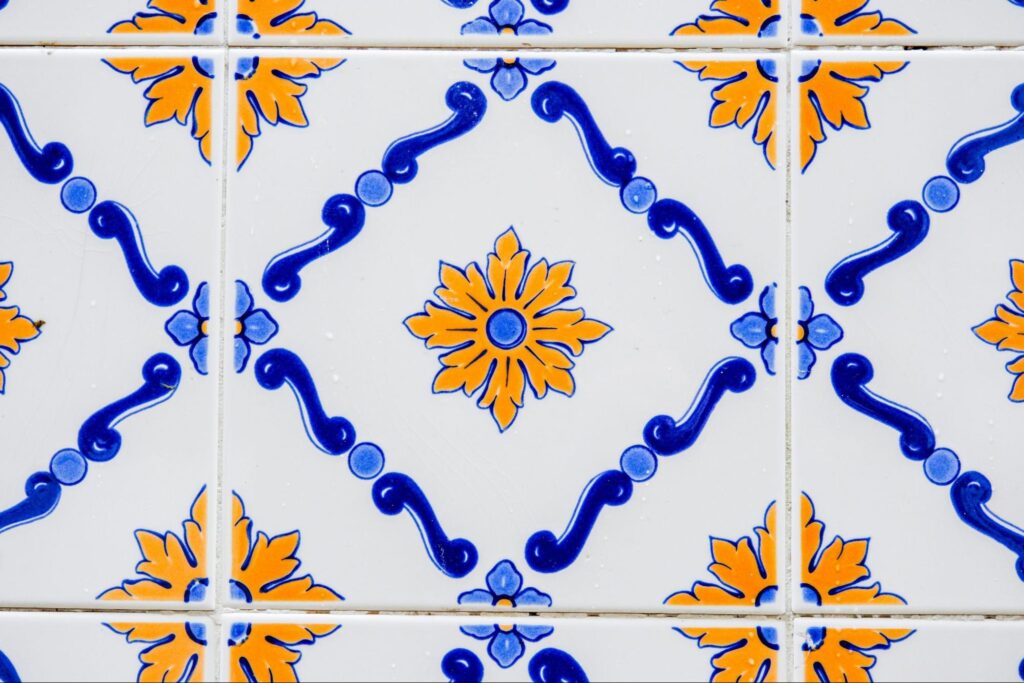
Not all paints are created equal when it comes to tiles. Floor surfaces need products that can withstand daily foot traffic, moisture, and even harsh chemicals from cleaning, so choosing the right type of paint is critical if you want the finish to last.
Here are the most reliable options of paint:
- Epoxy paint – this is the most durable choice for tiles. Epoxy forms a hard, protective shell that resists scratches, water, and stains. It’s especially good for kitchens, bathrooms, and entryways. The downside is that epoxy can be more difficult to apply, often requiring mixing two components and working quickly before it sets.
- Acrylic or latex floor paint with sealant – easier to apply than epoxy and widely available, these paints can still give good results if paired with a strong primer and a high-quality clear sealer. They work well in other areas like living rooms, bedrooms, or lighter-use spaces.
- Chalk paint with top coat – popular for its matte, rustic look, chalk paint can work on tiles if you apply several coats of polyurethane or a similar sealant. This option is better suited for decorative spaces rather than heavy-use areas.
Some brands floor paints are specially designed for durability and moisture resistance. No matter what paint you choose, always invest in a high-quality clear top coat. A water-based polyurethane or epoxy sealer adds a protective barrier that dramatically increases durability and makes cleaning easier.
If you want your paint job to look like it came from the factory, use a small roller instead of a brush. It applies the paint more evenly and reduces visible strokes.
Can All Tile Materials Be Painted?
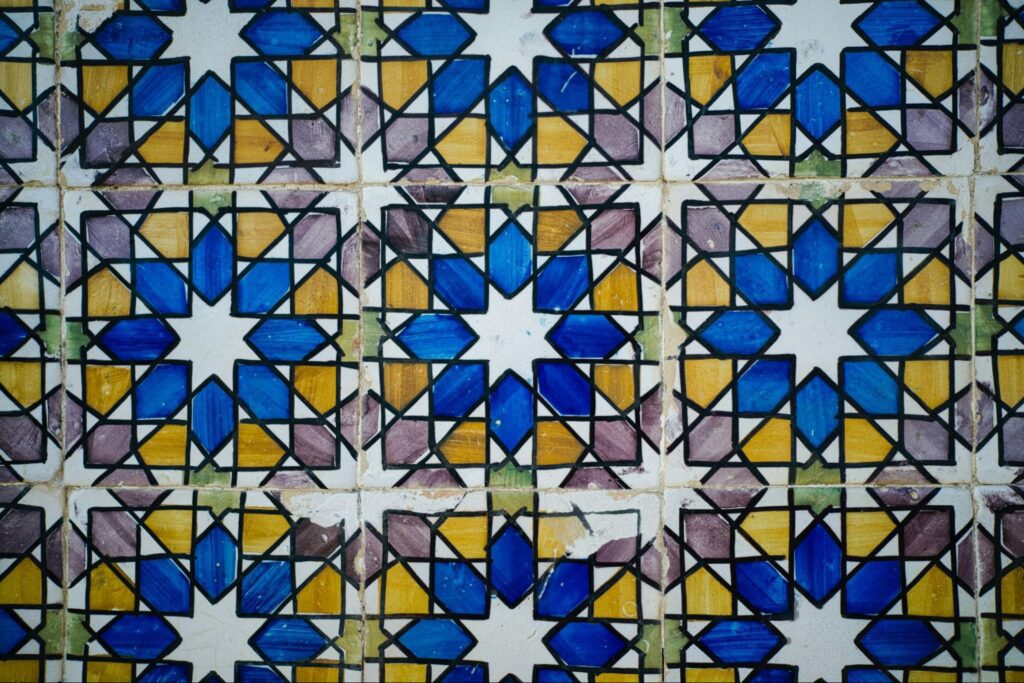
Most floor tiles can be painted, but some materials take paint better than others. The key is how well the surface allows the paint and primer to bond. If the tile is too smooth or porous, you’ll need to adjust your preparation.
- Ceramic tiles – common in homes, these are paint-friendly if you sand and prime properly.
- Porcelain tiles – denser and less porous, these require a strong bonding primer to grip.
- Natural stone tiles (slate, marble, travertine, granite) – can be painted but often lose their natural look. A strong sealer is essential.
- Glazed tiles – with glossy surfaces, they need sanding plus an adhesion primer.
Always test on a hidden tile first. If your tiles are cracked, chipped, or loose, repair them with paintable caulk or filler. Otherwise, paint won’t last.
How to Paint a Tile Floor
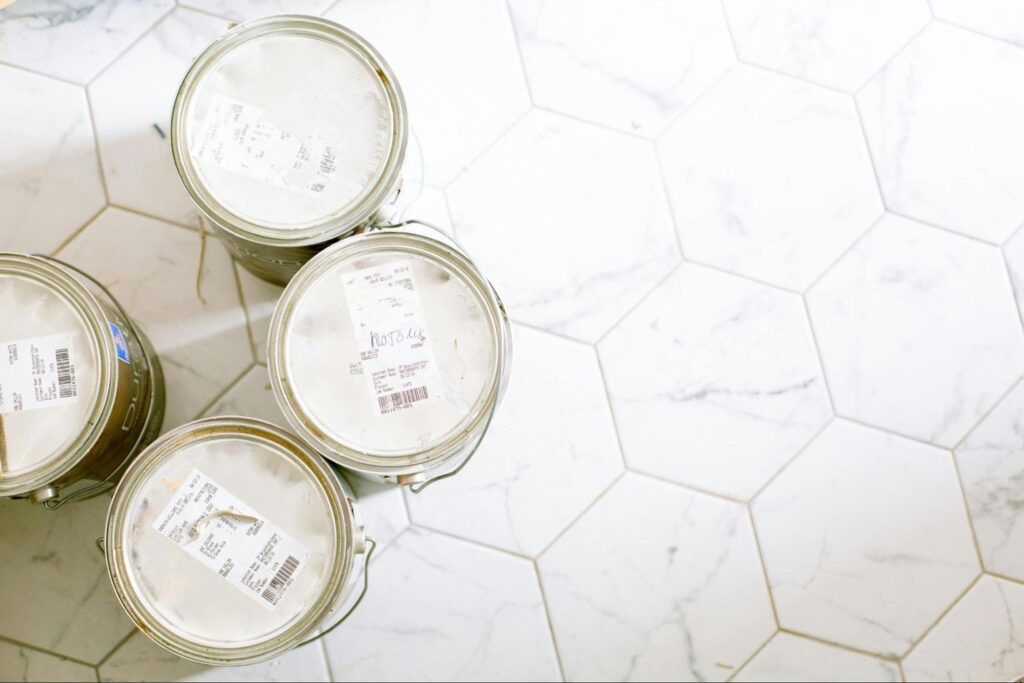
Painting a tile floor isn’t difficult, but it does require patience and careful preparation. Skipping steps usually means the paint won’t last.
1. Clean the Tiles
Wash the entire floor with sugar soap or a degreasing cleaner to remove dirt and grease. Afterward, wipe down with rubbing alcohol.
Let the tiles become completely dry before moving on.
2. Repair Cracks
Fill cracks or gaps in the grout lines with paintable caulk or epoxy filler. Smooth with a utility knife or putty knife, then let it cure.
3. Sand the Surface
Lightly sand the tiles with fine-grit paper to remove gloss. Vacuum the dust and wipe clean.
4. Apply Primer
Use a bonding primer as your base coat. Apply the first coat thinly with a brush on the grout and a roller on larger areas.
Let it become fully dry before the second coat.
5. Layer the Paint Coats
Apply the first coat of floor paint evenly. Let it reach the right drying time (usually overnight) before applying a second coat.
For patterned designs, allow the base to cure before layering stencils.
6. Seal the Paint
Finish with 2–3 coats of clear sealer. This keeps the paint durable, resistant to wet shoes, and safe against harsh chemicals. Wait until it is fully cured before heavy use.
How Long Does It Take for the Paint to Dry?
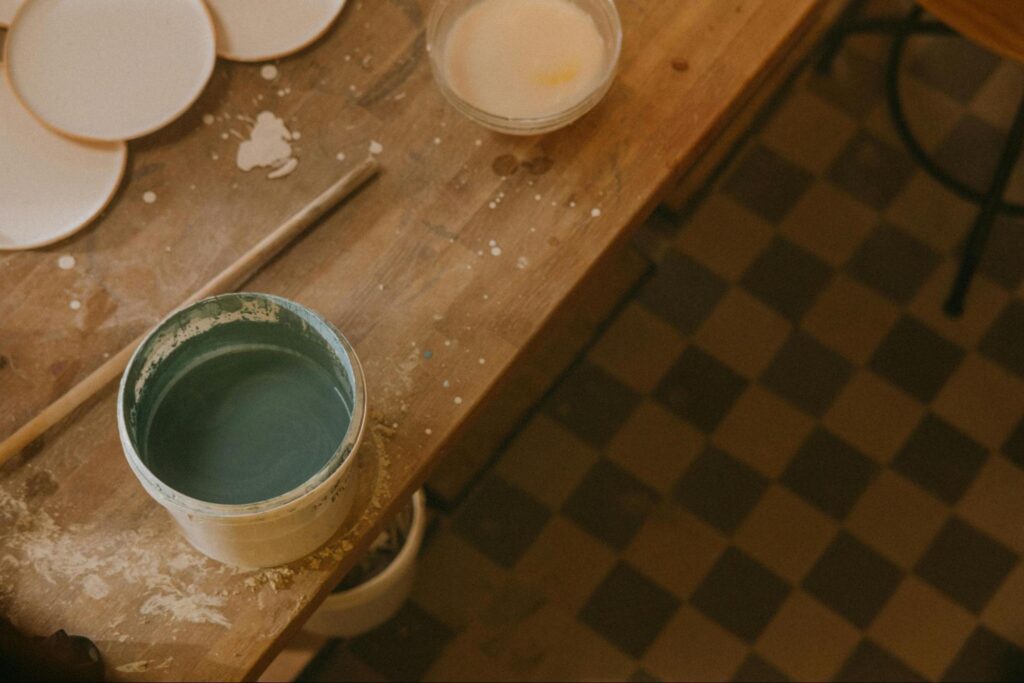
Depending on the type of paint and tiles, usually paint dries fully for 6-12 hours. Make sure that the paint is completely dry before doing the second coat.
Before sealing, let the last coat become fully dry overnight. The floor may be touch-dry within 24 hours, but allow 5-7 days to be fully cured.
During the first week, avoid heavy foot traffic or moving furniture.
Specifics for Bathroom and Kitchen Floors
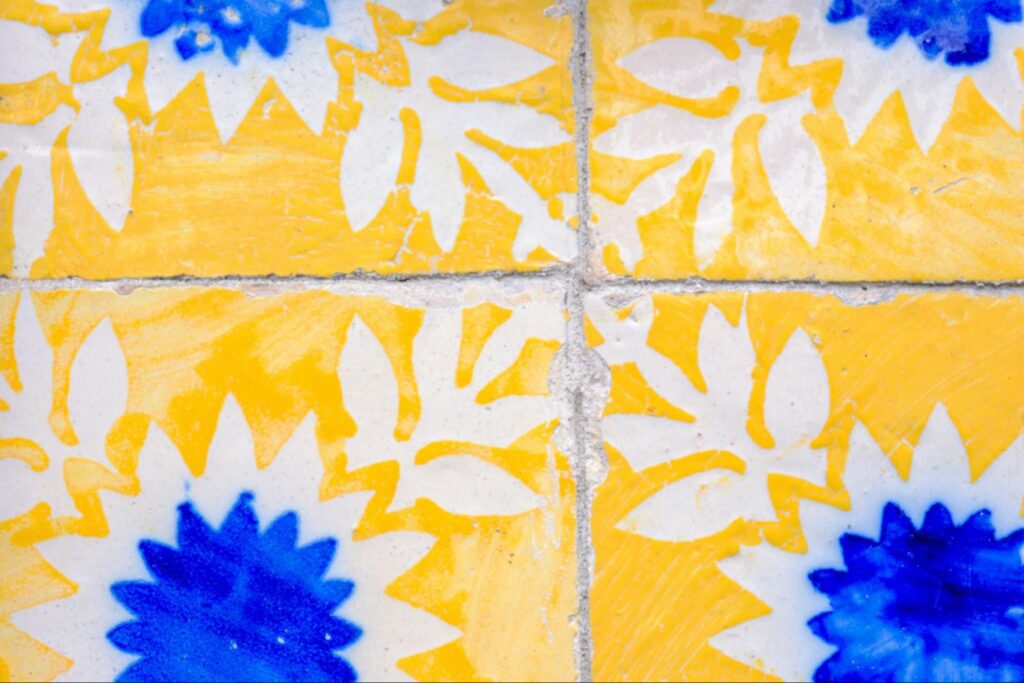
Bathrooms and kitchens need specially designed products like epoxy paint or acrylics with waterproof sealants.
Use a non-slip top coat to prevent slips near the sink or shower. Good airflow helps coats cure properly.
Remember, painted tiles are rarely a long term solution, but they can refresh your bathroom or kitchen nicely for a few years.
Removing Paint From Floor Tile
If you don’t like your painted floor, the good news is that you can easily strip the paint.
You can do this the following ways:
- Heat gun and scraper for small areas;
- Chemical strippers (check they’re safe for ceramic floor tiles and walls);
- Sanding/grinding – last resort since it can damage wood trims or scratch tiles.
If removal is too messy, repaint the entire floor with a new colour and seal it again. A variety pack of stencils can also help cover flaws.
Frequently Asked Questions
Can you suggest a budget-friendly way to refresh tiles without replacing them?
Painting them is the most cost-effective option. You can also add rugs, use peel-and-stick vinyl overlays, or stencil designs for a quick refresh.
Can you really paint floor tiles, or will the paint just peel off?
Yes, you can paint most floor tiles if you prepare them correctly. Sanding, priming, and sealing are essential steps to make sure the paint bonds and lasts.
What type of paint works best on bathroom floor tiles?
Epoxy paint is the most durable for bathrooms. It resists moisture, stains, and scratches better than acrylic or chalk paint.
Is epoxy paint really better than acrylic for tiles, or is it just harder to apply?
Epoxy is more durable but trickier to apply since it often requires mixing two components. Acrylic paints are easier to use and work fine in lighter-use spaces.
What mistakes should I avoid if I’m painting tiles for the first time?
Skipping sanding, using the wrong paint, applying thin or uneven coats, and walking on the floor before it cures are the biggest mistakes.

